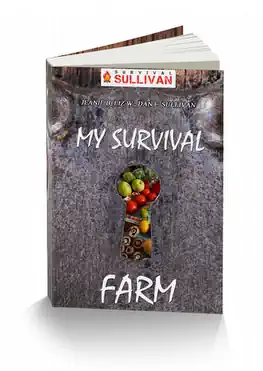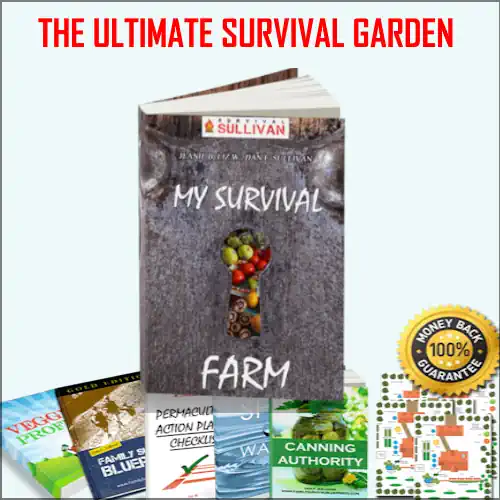Description
Unleash the Power of Your Survival Garden
Are you tired of relying on the broken food system? Ready to break free from rising grocery costs and potential food shortages?
It’s time to tap into the power of your survival garden. Imagine a garden that thrives with minimal maintenance and provides an abundance of organic produce. Picture a well-designed and secure garden that becomes your secret weapon during chaotic times.
Discover organic gardening methods that promote a healthy ecosystem and avoid the drawbacks of conventional farming.
Get ready to take charge of your food supply and embark on a journey towards self-sufficiency and survival.
Benefits of a Survival Garden
Discover the many benefits of having a survival garden. By creating a sustainable food source, you can ensure a steady supply of fresh, organic food for yourself and your family.
Unlike traditional gardens, a survival garden requires minimal maintenance – no watering, digging, fertilizing, or weeding necessary. It operates efficiently, producing up to 8 times more produce than conventional gardens. Even in small spaces, setting up and maintaining a survival garden is easy.
Not only does it provide healthy and nutritious food, but it also offers a hidden and secure design to protect your garden from unwanted attention. It can withstand extreme weather conditions, ensuring food security during times of crisis.
With a survival garden, you can have peace of mind knowing that you have a sustainable food source that requires minimal intervention.
Hidden and Secure Design
With a discreet and secure design, your survival garden remains completely hidden from prying eyes and potential threats. By maximizing space and using clever camouflage techniques, you can ensure that your garden stays unnoticed in plain sight. This not only protects your valuable food source but also maintains your freedom and security.
When working with limited space, it’s essential to make the most of every inch. Vertical gardening, raised beds, and companion planting are all effective ways to maximize productivity in a small area. Using natural materials and colors that blend with the surroundings can help camouflage your garden and make it less conspicuous to outsiders.
The Impending Food Crisis
Prepare for the upcoming food crisis by taking control of your food supply through the power of a survival garden. The impact of climate change and the solutions for food scarcity are important factors to consider in ensuring long-term survival.
A current example of the consequences of a severe food crisis can be seen in Venezuela, where citizens are experiencing hunger and desperation. In the United States, the combination of mega-drought, increasing reliance on food stamps, and a growing national debt poses a threat to food security. Economic factors and certain measures also contribute to this risk.
Organic Gardening Methods
To ensure the long-term survival and control over your food supply, it’s important to adopt organic gardening methods that prioritize sustainability and natural processes. By implementing these techniques, you can create a self-sustaining garden that provides fresh and nutritious food for you and your family.
Here are four reasons why sustainable agriculture is the way to go:
1. No constant weeding or pesticide use: Organic gardening allows nature to take care of the plants, bees, and ecosystem. This means you won’t have to spend endless hours pulling weeds or worrying about harmful chemicals.
2. Rainwater is sufficient for watering: Unlike conventional gardening methods that rely on excessive watering, organic gardening efficiently uses rainwater. Even during dry periods, your plants will thrive without the need for additional water.
3. Natural fertilizers enrich the soil: Instead of relying on synthetic fertilizers, organic gardening utilizes natural fertilizers that enrich the soil and provide essential nutrients to the plants. This promotes healthier and more robust growth.
4. Introduction of animals enhances the ecosystem: Organic gardening incorporates the presence of animals such as chickens or rabbits, which not only contribute to the ecosystem but also help regulate pests naturally.
Drawbacks of Conventional Gardening and Farming
Conventional gardening and farming have their share of disadvantages. One major issue is soil degradation. The constant tilling and plowing of the land disrupt the natural structure of the soil, leading to its degradation over time. This degradation results in the soil losing its ability to retain water and nutrients, which ultimately affects the growth and health of crops.
Conventional farming methods often involve the use of synthetic fertilizers and pesticides, which can have harmful effects on human health. These chemicals can contaminate the soil, water, and air, posing serious health concerns for both farmers and consumers.
It’s important to be aware of these drawbacks and consider alternative methods, such as organic gardening, to ensure the health and sustainability of our food systems.
Maximizing Your Survival Garden’s Potential
Maximizing the Potential of Your Survival Garden
To make the most of your survival garden, it’s important to implement strategies that will maximize its potential. Here are four key ways to achieve this:
1. Building Community: Your survival garden can play a crucial role in building a strong and resilient community. By sharing your knowledge and resources with neighbors and friends, you can inspire them to start their own gardens. Working together, you can create a network of self-sufficiency and support.
2. Self-Sufficiency: Your survival garden is a powerful tool for achieving self-sufficiency. By growing your own food, you can reduce your dependence on grocery stores and the industrial food system. This not only provides you with a sustainable source of nutrition but also empowers you to take control of your well-being.
3. Resilience: Your survival garden is an essential component of resilience during times of crises and uncertainty. By growing your own food, you ensure a reliable source of sustenance, even in times of scarcity. This resilience extends beyond food security, as it strengthens your ability to adapt and thrive in challenging circumstances.
4. Continual Improvement: Your survival garden is a dynamic and evolving system. It’s important to continually seek ways to improve its efficiency and productivity. Experiment with different planting techniques, companion planting, and natural pest control methods. By constantly learning and adapting, you can maximize the potential of your survival garden and ensure its long-term success.
This special type of garden can feed you and your family in times of crisis and is actually healthier than gardening and is perfect for survival purposes.
 Imagine the satisfaction of stepping into your own survival garden, surrounded by lush greenery and a bountiful harvest. As you pick your fresh, organic vegetables, you feel a sense of empowerment and security, knowing that you have taken control of your food supply.
Imagine the satisfaction of stepping into your own survival garden, surrounded by lush greenery and a bountiful harvest. As you pick your fresh, organic vegetables, you feel a sense of empowerment and security, knowing that you have taken control of your food supply.
This low-maintenance garden is a game-changer, requiring no watering, digging, or weeding. In a world where food costs are rising and potential shortages are a concern, having a survival garden ensures a steady supply of nourishing food for you and your family.
Prepare to tap into the power of your garden and thrive in any situation.




